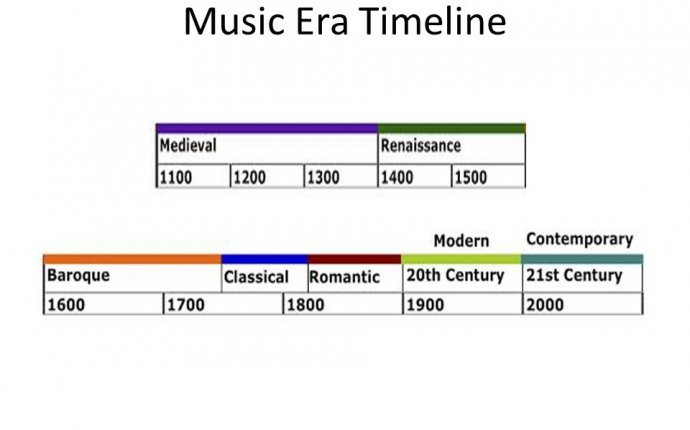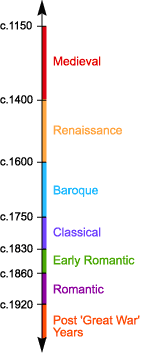
baroque music history timeline

This is the first period where we can begin to be fairly certain as to how a great deal of the music which has survived actually sounded. The earliest written secular music dates from the 12th century troubadours (in the form of virelais, estampies, ballades, etc.), but most notated manuscripts emanate from places of learning usually connected with the church, and therefore inevitably have a religious basis. Gregorian chant and plainsong which are monodic (i.e. written as one musical line) gradually developed during the 11th to 13th centuries into organum (i.e. two or three lines moving simultaneously but independently, therefore almost inadvertently representing the beginnings of harmony). Organum was, however, initially rather stifled by rigid rules governing melody and rhythm, which led ultimately to the so-called Ars Nova period of the 14th century, principally represented by the composers de Vitry, Machaut, and Landini. Recommended Recording: The fifteenth century witnessed vastly increased freedoms, most particularly in terms of what is actually perceived as 'harmony' and 'polyphony' (the simultaneous movement of two or three interrelated parts). Composers (although they were barely perceived as such) were still almost entirely devoted to choral writing, and the few instrumental compositions which have survived often create the impression (in many cases entirely accurately) of being vocal works in disguise, but minus the words. There is obvious new delight in textural variety and contrast, so that, for example, a particular section of text might be enhanced by a vocal part dropping out momentarily, only to return again at a special moment of emphasis. The four most influential composers of the fifteenth century were Dunstable, Ockeghem, Despres and Dufay. The second half of the 16th century witnessed the beginnings of the tradition which many music lovers readily associate with the normal feel of 'classical' music. Gradually, composers moved away from the modal system of harmony which had predominated for over 300 years (and still sounds somewhat archaic to some modern ears), towards the organisation of their work into major and minor scales, thereby imparting the strong sensation of each piece having a definite tonal centre or 'key'. This was also something of a golden period for choral composition as a seemingly endless flow of a capella (unaccompanied) masses, motets, anthems, psalms and madrigals flowed from the pens of the masters of the age. In addition, instrumental music came into its own for the first time, especially keyboard music in the form of fantasias, variations, and dance movements (galliards, pavanes etc.). Composers of particular note include Dowland, Tallis, Byrd, Gibbons, Frescobaldi, Palestrina, Victoria, Lassus, Alonso Lobo, Duarte Lobo, Cardoso and Gesualdo. Recommended Recordings:
During the Baroque period, the foundations were laid for the following 300 or so years of musical expression: the idea of the modern orchestra was born, along with opera (including the overture, prelude, aria, recitative and chorus), the concerto, sonata, and modern cantata. The rather soft-grained viol string family of the Renaissance was gradually replaced by the bolder violin, viola and cello, the harpsichord was invented, and important advances were made in all instrumental groups. Until about 1700, the old modes still exerted themselves from time to time by colouring certain melodic lines or chord progressions, but from the beginning of the 18th century the modern harmonic system based upon the major and minor scales was effectively pan-European. Choral music no longer dominated, and as composers turned more and more to writing idiomatic instrumental works for ensembles of increasing colour and variety, so 'classical' music (as opposed to 'popular') gradually began to work its way into the very fabric of society, being played outdoors at dinner parties or special functions (e.g. Handel's Water Music), or as a spectacle in the form of opera. On a purely domestic level, every wealthy lady would have a spinet to play, and at meal-times the large and rich houses would employ musicians to play what was popularly called Tafelmusik in Germany, of which Telemann was perhaps the most famous composer. Of the many 17th century composers who paved the way for this popular explosion of 'classical' music, the following were outstanding: Monteverdi, Corelli, Alessandro Scarlatti, Schutz, Buxtehude, Purcell and Lully. Yet, the most popular composers of the period, indeed those who seem to define by their very names the sound of Baroque music at its most colourful and sophisticated are Johann Sebastian Bach, Handel, Telemann, Rameau, François Couperin, Domenico Scarlatti, and Vivaldi, all of them at their creative peak during the first half of the 18th century. The Baroque era witnessed the creation of a number of musical genres which would maintain a hold on composition for years to come, yet it was the Classical period which saw the introduction of a form which has dominated instrumental composition to the present day: sonata form. With it came the development of the modern concerto, symphony, sonata, trio and quartet to a new peak of structural and expressive refinement. If Baroque music is notable for its textural intricacy, then the Classical period is characterised by a near-obsession with structural clarity. The seeds of the Classical age were sown by a number of composers whose names are now largely forgotten such as Schobert and Honnauer (both Germans largely active in Paris), as well as more historically respected names, including Gluck, Boccherini and at least three of Johann Sebastian Bach's sons: Carl Phillip Emmanuel, Wilhelm Friedmann and Johann Christian (the so-called 'London' Bach). They were representative of a period which is variously described as rococo or galante, the former implying a gradual move away from the artifice of the High Baroque, the latter an entirely novel style based on symmetry and sensibility, which came to dominate the music of the latter half of the 18th century through two composers of extraordinary significance: Joseph Haydn and Wolfgang Amadeus Mozart. |









